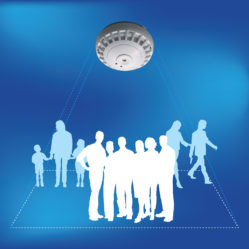How people counting technology is saving businesses thousands
Throughout the course of the pandemic, social distancing restrictions led to a rapid increase in the retail sector’s reliance on occupancy rates, with the majority of high-street stores having to restrict their number of visiting customers in order to comply with Government guidelines. While collecting data from people counting technology is a widely accepted practice of forward-thinking retailers, who are using the data to benefit their general business operations, the restrictions enforced on retail due to COVID-19 (thankfully now lifted) led to the emergence of a new string to the bow of people counting technology.
Transitioning from staff to technology
During the COVID-19 pandemic, many stores and retail outlets initially chose to install members of staff at the entrance and exit in order to monitor the occupancy levels of the store. While this seemed a reasonable short-term fix, many retail businesses inadvertently found themselves paying tens of thousands of pounds to count how many people were instore at any one time.
Based on calculations using the UKs National Minimum wage, a retailer could spend upwards of twenty-five thousand pounds a year* employing a staff member to monitor the occupancy rate of a store by covering the main entrance. This unexpected cost is likely to have punched a considerable hole in almost any retailer’s annual budget, especially when the cost can easily be reduced dramatically by embracing dynamic technological practices.
Using integrated technological devices to carry out real time occupancy monitoring and alerting solutions in a retail outlet is not only a significantly more economically-valuable alternative, but it also produces more accurate data, with the industry’s leading solutions, such as countIT, delivering an accuracy rate of 99.5% while protecting customer privacy, as well as a raft of additional features such as dwell detection, height data and in-built heat mapping to allow store managers to identify trends.
Data collected through people-counting can provide a unique insight into customer behaviours
Collecting data across a quarterly period enables businesses to spot trends in their foot traffic according to the days in which the number of customers visiting the premises are at their peak. Not only does this allow managers to adjust their business’ opening hours to accommodate for busier periods, but is also facilitates other important strategic changes, such as modifying the number of staff members required for a particular shift. Optimising staff scheduling is a simple way for a retail business to save money, as it eliminates the possibility of losing profit as a result of overstaffing during quieter sales periods.
Evaluating customer conversion rates is an important part of a business’ marketing strategy, particularly for retail company stores wishing to measure the commercial success of certain campaigns. Figures showing fluctuations in a store’s foot traffic, as well as customer behaviour instore, can be cross-referenced with the introduction of specific changes in strategy, such as a new window display or a different in-store soundtrack, enabling management to determine how successful these decisions have been for the business.

With advanced counting technologies, businesses can record up-to-date data whose value is not only lucrative but versatile.
The newest technologies are allowing for more sophisticated methods of people counting, which in turn is making an investment in people counting solutions extremely attractive to a much wider variety of industry sectors. Due to factors such as these, the overall counting system market size is predicted to grow from GBP 585 million in 2020 to GBP 953 million by 2025, a 63% increase in the space of just five years.
*Based on calculations using the UKs National Minimum wage, a retailer would pay £25,945.92 a year for a single member of staff to monitor the occupancy rate of a store by covering the main entrance for 8 opening hours per day, 7 days a week.






